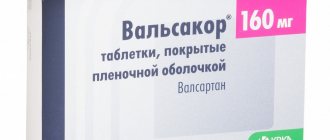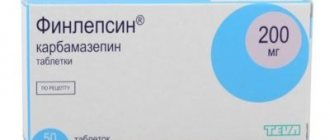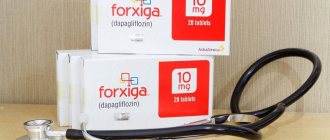Release form and composition
Neurox is available in the form of a solution for intravenous and intramuscular administration: a clear, colorless or slightly yellowish liquid (2 ml in dark glass ampoules, five ampoules in strip packs, in a cardboard pack of 1, 2, 4 or 10 strip packs; 5 each ml in dark glass ampoules, five ampoules in blister packs, in a cardboard pack 1, 2 or 4 blister packs; 10 ml or 20 ml in dark glass ampoules, one ampoule in blister packs, in a cardboard pack 1 blister pack ).
Composition per 1 ml of solution:
- active ingredient: EMGPS (ethylmethylhydroxypyridine succinate) – 50 mg;
- auxiliary components: water for injection, sodium disulfite.
Analogs
If the use of Neurox is impossible, it is replaced with medical products that have the same composition or have similar properties.
Structural
On the pharmacological market there are the following structural analogues of Neurox:
Mexidol is available in 3 dosage forms: injection solution, tablets, toothpaste. Its use is prescribed for atherosclerosis, VSD, problems with cerebral circulation, dental diseases and diseases accompanied by tissue hypoxia. Can be prescribed to children over 12 years of age. Average cost of the drug: from 256 rubles. – tablets, from 506 rub. – solution.- Cerecard is an antioxidant produced by a Russian manufacturer. The drug is presented in the form of a solution. It is injected into a muscle or vein. Recommended for patients with neurological diseases and poor blood flow in the brain who have suffered a heart attack (the solution is prescribed in the first days of rehabilitation). Has the same restrictions on use as Neurox. The cost of the product is from 130 rubles.
- Ethoxidol is an antioxidant available in the form of tablets and injection solution. It has the same indications and restrictions for use as Neurox. Its average cost is 770 rubles.
- Mexicor - this antioxidant is produced in the form of a solution and capsules. Prescribed for ischemic stroke, discirculatory encephalopathy, mild speech and memory disorders of various etiologies, coronary artery disease and after myocardial infarction.
Contraindicated in patients with liver and kidney failure, intolerance to its components, as well as pregnant women and children under 18 years of age. You can buy tablets for 140-160 rubles. Cost of the drug in the form of a solution: 360-410 rubles. – for 10 ampoules of 2 ml, 900-1000 rubles. – per pack of 20 ampoules of 5 ml. - Venokor – has antioxidant, nootropic, anticonvulsant and adaptogenic properties. Recommended for coronary heart disease, atherosclerosis, acute disorders of blood flow in the brain. Available in the form of a solution. You can buy it for 790 rubles.
- Meksifin is one of the most accessible structural analogues of Neurox. It costs only 150 rubles. Effective for acute cerebrovascular accidents, dystonia, cognitive disorders of atherosclerotic origin, alcohol withdrawal syndrome. Not prescribed for children, pregnant women, or with kidney and liver failure.
All these drugs are identical in composition and therapeutic effect to Neurox. Medicines differ only in the country of origin and price.
Drugs with a similar principle of action
There are many drugs on the pharmacological market that have the same indications for use as this medicine. The list of the most well-known substitutes for this drug includes:
- Piracetam belongs to the group of nootropics. Available in the form of capsules and solution.
Attributed to patients with cerebral atherosclerosis, parkinsonism, Alzheimer's disease, withdrawal syndrome due to alcoholism and drug addiction, as well as diseases of the nervous system, in which there is a decrease in intelligence and memory, and a violation of the emotional-volitional sphere. The main active ingredient of the drug is piracetam. You can buy it for 30-50 rubles.
Hypoxen – has antihypoxic and antioxidant effects. The release form of this medicine is capsules.Recommended for increased fatigue and tiredness, the need to increase performance in extreme situations that are accompanied by a lack of oxygen. Can be used in the complex treatment of severe injuries, significant blood loss and angina pectoris, chronic failure of the heart muscle. The cost of the drug is 470-500 rubles. per package (30 capsules).
Before replacing Neurox with structural analogues or agents with a similar principle of action, you should consult your doctor.
Pharmacological properties
Pharmacodynamics
EMHPS belongs to 3-hydroxypyridines. It inhibits free radical processes and is a membrane protector with nootropic, antihypoxic, anticonvulsant, stress-protective and anxiolytic activity. The mechanism of its action is associated with membrane protective and antioxidant properties. EMGPS inhibits the process of lipid peroxidation, enhances the activity of the enzyme superoxide dismutase, increases the lipid/protein ratio, and also improves the function and structure of the cell membrane. The drug modulates the activity of receptor complexes and membrane-bound enzymes, promoting their binding to ligands, improving transmission between synapses and preserving the structure and function of biological membranes and neurotransmitter transport. Under the influence of EMGPS, the concentration of the hormone dopamine in the brain increases. Under conditions of oxygen starvation, it increases the compensatory activation of aerobic glycolysis and reduces the degree of inhibition of oxidation processes in the Krebs cycle.
In case of cerebrovascular accidents, ischemia and hypoxia, shock, intoxication with antipsychotic drugs and ethanol, Neurox increases the body's resistance to the influence of various damaging factors. It improves microcirculation, blood supply and metabolism in the brain, blood rheology, and reduces platelet aggregation. The drug stabilizes the membranes of red blood cells and platelets, resulting in a reduced likelihood of hemolysis. The lipid-lowering effect is manifested by a decrease in the content of total cholesterol and low-density lipoproteins.
In case of myocardial ischemia, Neurox reduces the area of necrosis, normalizes metabolism in the heart muscle, improves and/or restores contractility and electrical activity of the myocardium, increases coronary blood flow, enhances the antianginal effect of nitro drugs and neutralizes the consequences of reperfusion syndrome in patients with acute coronary insufficiency.
The stress-protective effect of the drug is manifested in the restoration of impaired memory and learning processes, sleep-wake cycles, normalization of somatovegetative disorders and behavior after stress, and reduction of dystrophic changes in brain structures.
In case of withdrawal syndrome, EMGPS has a pronounced antitoxic effect. It eliminates the neurotoxic and neurological manifestations of alcohol poisoning, and also corrects decreased memory and mental performance and behavioral disorders.
EMGPS enhances the effect of neuroleptic, hypnotic, tranquilizing, anticonvulsant and antidepressant drugs, which makes it possible to reduce their doses and reduce unwanted side effects.
Pharmacokinetics
After intramuscular administration, the drug is detected in the blood within 4 hours. The time to reach maximum plasma concentration is 0.3–0.58 hours. When Neurox is administered intramuscularly at a dose of 400–500 mg, the maximum plasma concentration is 2.5–4 μg/ml. The active substance of the drug quickly enters the tissues and organs from the blood and is then excreted from the body. When administered intramuscularly, EMGPS is retained in the body for about 0.7–1.3 hours.
Metabolism occurs in the liver by glucuronidation. Over 12 hours, about 50% of the administered dose is excreted in the urine in the form of metabolites and about 0.3% unchanged. The most intense elimination occurs in the first 4 hours after injection. The elimination parameters of Neurox in the form of metabolites and in unchanged form vary significantly among different patients.
special instructions
Prescribing Neurox, Mexidol and Cerecard to certain categories of patients should be done with caution.
Drug interactions
Neurox and its substitutes increase the effectiveness of benzodiazepine tranquilizers, anticonvulsants and antiparkinsonian drugs. When used in combination with Nitroglycerin, a mutual enhancement of the effects of the drugs is observed. No consequences of interaction between Neurox and other drugs have been identified.
Alcohol compatibility
The drug is often used in the treatment of patients who have suffered from chronic alcoholism and are trying to give up this habit. Many people mistakenly believe that using the medicine in combination with alcoholic beverages does not harm the body, because Neurox neutralizes the toxic effects of ethanol. It is not advisable to use the drug in this case. Treatment is ineffective for alcohol abuse.
Injections and tablets can only be used to relieve withdrawal symptoms. The active substance eliminates signs of intoxication and reduces cravings for alcohol.
Impact on the ability to drive vehicles and complex mechanisms
Neurox can cause dizziness, impair coordination of movements and reduce the speed of psychomotor reactions. During the treatment period, it is recommended to refrain from driving a car or operating complex machinery.
Use during pregnancy and lactation
The effect of the drug on fetal development has not been studied. The use of the drug during pregnancy is not recommended. Active substances can be excreted in breast milk, so lactation is also included in the list of contraindications.
Use in childhood
According to the instructions for use, childhood is a contraindication to the administration of Neurox solution. This is explained by the lack of objective data on the effect of the active substance on the developing organism. In practice, neurologists often prescribe this drug to patients under 18 years of age. Injections accelerate the recovery of the nervous system during infections and traumatic brain injuries. The use of the drug prevents the development of such consequences as:
- decreased concentration;
- disturbance of psycho-speech development;
- hyperactivity;
- irritability and aggression.
The antihypoxic effect allows Neurox to be used in the treatment of newborns who have suffered hypoxia. The administration of the drug prevents the development of cerebral syndrome.
Use for liver and kidney dysfunctions
A contraindication to the administration of the drug is acute renal failure. For mild kidney disease, dose adjustment is required. The use of the drug for cirrhosis and acute liver diseases is prohibited. For mild liver failure, the medicine is used under the supervision of a doctor.
Indications for use
Indications for Neurox are the following diseases and conditions:
- DEP (dyscirculatory encephalopathy);
- mild cognitive impairment of atherosclerotic origin;
- acute circulatory disorders in the brain (in complex treatment);
- NCD (neurocirculatory dystonia);
- anxiety states accompanying neurosis-like and neurotic disorders;
- acute poisoning with antipsychotic drugs;
- alcohol withdrawal syndrome with a predominance of vegetative-vascular and neurosis-like disorders.
Efficiency
The positive effect of using Neurox is confirmed by reviews of doctors and patients who have used it for various diseases.
Reviews from doctors
Experts say that Neurox is a good antioxidant, anticonvulsant and antihypoxic drug, but in most cases it is better to use it as an adjuvant remedy, in combination with drugs from other groups:
Vashko A.V., cardiologist: “Neurox is effective for neurological disorders and cardiovascular diseases. If the drug is prescribed for a heart attack or coronary insufficiency, it must be used simultaneously with other drugs. It helps to quickly restore blood circulation in the heart muscle and improve its function. Even in high doses, the medicine is well tolerated.”
Avdeev K.A., neurologist: “I often prescribe this medicine to my patients. I attribute the drug to those who have circulatory disorders in the brain, ischemic areas and other diseases included in the list of indications for its use. The main thing is to administer the medicine strictly according to schedule and simultaneously undergo therapy with other drugs.”
Neurox, instructions for use (method and dosage)
Neurox is intended for intramuscular or intravenous (stream or drip) administration. A 0.9% sodium chloride solution should be used as a solvent for infusion administration.
Doses of the drug are selected individually. The initial dose is 50–100 mg 1 to 3 times a day. Then it is gradually increased until the required therapeutic effect is achieved.
Intravenous jet administration is carried out slowly, over 5–7 minutes; The drug is administered intravenously at a rate of 40–60 drops per minute.
The maximum dose of Neurox is 800 mg per day.
Recommended doses of the drug and duration of treatment for various indications:
- DEP (in the decompensation phase): 100 mg 2 or 3 times a day intravenously by drip or stream during the first 14 days; over the next 14 days - 100 mg per day intramuscularly;
- DEP (course prophylaxis): 100 mg 2 times a day intramuscularly, course duration – 10–14 days;
- mild cognitive impairment in elderly patients, anxiety states: 100–300 mg per day intramuscularly, duration of therapy – from 14 to 30 days;
- acute circulatory disorders in the brain: 200–300 mg per day intravenously in the first 2–4 days, in subsequent days – 100 mg 3 times a day intramuscularly; course duration – 10–14 days;
- NDC: 50–400 mg per day intramuscularly for 14 days;
- acute poisoning with antipsychotic drugs: 50–300 mg per day intravenously, course of treatment – 7–14 days;
- alcohol withdrawal syndrome: 100–200 mg 2 or 3 times a day intramuscularly or 100–200 mg 1 or 2 times a day intravenously, course of treatment – 5–7 days.
Drug interactions
The effect of Neurox may vary depending on concomitant use with other medications. To avoid the development of severe adverse reactions, you should consult a specialist before use. The following drugs should be combined with caution:
- antiepileptics (Carbamazepine), antiparkinsonian (Levodopa, Carbidopa);
Neurox injections enhance the effect of these medications.
- Ethanol;
The drug reduces the toxic effect of alcohol metabolites on the body.
- benzodiazepine tranquilizer (Diazepam), nitrates (Nitroglycerin);
Neurox leads to potentiation (increased effect) of these drugs.
Side effects
During treatment with Neurox according to indications (especially with intravenous jet administration), the following adverse reactions are possible: a metallic taste and dryness in the mouth, sore throat, a feeling of lack of air, a feeling of discomfort in the chest, a feeling of warmth spreading throughout the body. The listed side effects are often due to the high rate of administration of the solution and are short-term.
Long-term treatment can lead to adverse effects such as nausea, difficulty falling asleep, drowsiness, and flatulence.
Allergic reactions may develop.
Possible consequences and precautions
Negative consequences usually do not occur during Neurox therapy. But sometimes after its use the following symptoms occur:
- metallic taste in the mouth;
fever, feeling of warmth in the body;- heaviness in the chest;
- dry mouth;
- sore throat;
- labored breathing;
- drowsiness or, conversely, insomnia;
- nausea;
- vomit;
- bloating;
- colic;
- rash, itching and burning, swelling of the skin.
If at least one of the above symptoms appears, you should consult a doctor. He will adjust the dosage of Neurox or prescribe another drug.
Overdose of the drug is possible with prolonged use or administration of large doses. Its main features:
- constant drowsiness;
- difficulty falling asleep;
- increased blood pressure (slight).
As a rule, all these symptoms do not require additional therapeutic measures: they disappear within 24 hours. In rare cases, the following may be prescribed: Diazepam or Nitrazepam - for sleep disturbances, drugs with antihypertensive effects - for high blood pressure.
Evaluation of the effectiveness of treatment with Neurox and Mexidol
If you drink alcohol during Neurox therapy, the effect of alcohol on the body is inhibited. But combining the drug with alcoholic drinks is not recommended: when taking large doses of ethanol, you may need to increase the dosage of the drug. This threatens to cause an overdose and reduce the effectiveness of the therapy.
Drowsiness may occur while using the drug. Therefore, during the period of treatment, it is recommended to refrain from driving vehicles or working with mechanisms that require concentration.
Overdose
In case of an overdose of Neurox, sleep is disturbed (insomnia appears, and sometimes drowsiness); if the drug was administered intravenously, a short-term and slight increase in blood pressure is possible.
Overdose symptoms usually go away on their own within 24 hours. For severe insomnia, it is recommended to prescribe oxazepam or nitrazepam at a dose of 10 mg or diazepam at a dose of 5 mg. Excessively high blood pressure is reduced under control using antihypertensive drugs.
Reviews of Neurox
The drug is quite often prescribed in the complex treatment of various neurological disorders, as well as for persons with alcohol withdrawal syndrome. According to reviews, Neurox is effective in most cases and helps improve the patient’s condition (dizziness disappears, the person feels calmer). Reviews about the ineffectiveness of the drug are rare, but there are a lot of reports that talk about the side effects of the drug (feeling hot, sore throat, severe dizziness and headaches, increased blood pressure). To reduce the risk of these side effects, it is recommended to administer the drug as slowly as possible.







